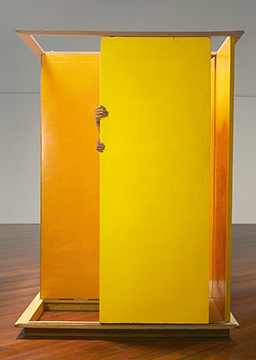Hélio Oiticica: To Organize Delirium
@ The Art Institute of Chicago
111 S Michigan Ave, Chicago, IL 60603
On view through Sunday, May 7th
Hélio Oiticica (1937–80) is arguably the most influential Latin American artist of the post–World War II period and is recognized for his significant contributions to the development of contemporary art. A relentless innovator always pushing the traditional boundaries of art, Oiticica moved rapidly and radically from early works influenced by European modernism to large-scale installations that were meant to be physically experienced and often to critique political and social issues. This exhibition offers the first retrospective in the United States of the Brazilian artist’s groundbreaking and influential achievements.
Demonstrating the great breadth of the artist’s work, the exhibition begins with the adventurously elegant works on paper from early in Oiticica’s career (1955–58). These progressively dynamic compositions paved the way for his works that liberated painting from a flat plane. By 1959, Oiticica’s painterly-sculptural Spatial Reliefs and Nuclei broke free of the wall and entered the space of the viewer. The Nuclei, composed of panels suspended from the ceiling, created areas through which the viewer could walk. His later installations continued to revolutionize the role of the viewer, as they responded to the increasingly oppressive political situation in Brazil under the military dictatorship. Oiticica’s most famous work, Tropicália (1967) brings together a series of clichés associated with tropicalness—sand, gravel, exotic birds, and lush foliage—which was contrasted with a television monitor that emits continuous images and sounds. Tropicália, a name subsequently borrowed by the musician Caetano Veloso for his anthem against Brazil’s dictatorship, became a powerful movement in all the arts—a political position both against the right’s conservatism and the left’s desire for a purely Brazilian art.
Throughout his brief but energetic career, Oiticica seamlessly melded formal and social concerns in his art, seeking to be internationally relevant and, at the same time, specifically Brazilian. Above all, he aimed to communicate to his audiences the deep pleasure and satisfaction inherent in creative work. That aim reached fruition as his career advanced and his art took on an increasingly immersive nature, transforming the viewer from a spectator to an active participant or “participator.†This exhibition is the first anywhere to treat these later works in depth, acknowledging Oiticica’s New York years (1971–78) and his return to Brazil (1978–80) as discrete periods within his career. In addition to viewing the original works on display, visitors will be invited to take off their shoes and walk through sand-filled installations, view Amazonian parrots, and try on exhibition copies of Oiticica’s Parangolés, objects he created to be carried or worn and among the artist’s most radical contributions to contemporary art.
A fully illustrated catalogue covering the artist’s entire career in essays by authors from the United States and Latin America accompanies the exhibition.
Organizers
Hélio Oiticica: To Organize Delirium is organized by the Art Institute of Chicago; Carnegie Museum of Art, Pittsburgh; and the Whitney Museum of American Art, New York
Official Website
More events on this date
Tags: Chicago, Helio Oiticica, Loop, The Art Institute of Chicago, To Organize Delirium

« previous event
next event »